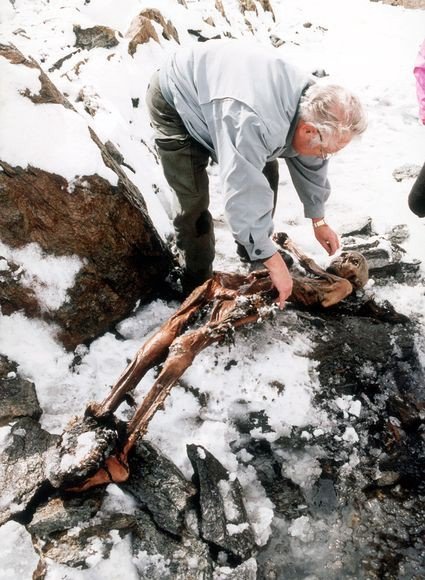OTZI: A WARNING TO ALL HISTORIANS
Ötzi’s frozen, mummified remains were found in the Ötzal Alps in 1991. Image from History of Yesterday.
I first met Ötzi, the ice man, in Japan in 2005. He was on tour with his South Tyrolean Museum keepers. I’d been following his adventures into the modern world since that Thursday, September 19, 1991, when two tourists spotted his skull emerging from the ice in the Tisenjoch pass in the Ötztal region of the Alps.
The discovery rapidly went from ‘Not another body!’ and a lot of cursing at all the bureaucratic problems that were involved, to ‘Wow! What a wonderful find.’ when Austrian archaeologist, Konrad Spindler, identified the axe found with the body. This was not just a lost traveler but a neolithic man, from around 3,300 BCE, a staggering 5,300 years old. The discovery caused an international furore, all the world was interested in Ötzi, wanting to know more, and so the scientific investigations began.
What was learned? That Ötzi is a warning to all historians and archaeologists, reminding them to be mentally flexible and adaptive. They can’t stick to the first theories and ideas, because facts can change, especially when technology is involved. For thirty years researchers have minutely examined and investigated Ötzi's frozen body, clothing and equipment and have had to change their minds many times. Back in the 1990s only x-ray was available. X-ray showed that Ötzi had broken ribs, no stomach, and no genitals. He was probably a lost bronze age alpine shepherd who’d maybe taken a tumble or been in a fight?
Within ten years MRI scanning was available. Ribs weren’t broken, the stomach and genitals were found and examined as was that dark mass under the left shoulder blade. The team found it to be an arrow head. Ötzi’d been shot in the back - murdered?
With the improved DNA techniques of the 21st century genetic exploration was possible. Austrian scientists have found that 19 Tyrolean men alive today are related to Ötzi. Ötzi’s reed cape, sheepskin coat and goat skin leggings have been analyzed down to the last hair. His teeth have been mined for details of diet, use, and where he was born. The type of worm eggs in his gut and his fleas said something of neolithic lifestyles as did the tattoos inked on his skin. We now know his final meal was dried ibex meat and fat, red deer, einkorn wheat, with traces of moss and bracken fern, possibly wrapped around his food? That energy-rich fat was vital for alpine hunters. And still the scientists are arguing over what they found and keep finding. Sacrifice or murder? Reed mat or cape? We might have had Ötzi for 30 years but he is still forcing researchers to re-think and re-examine what they thought was his history.
A life-size model of what Ötzi, the ice man, may have looked like. Located in the South Tyrol Museum of Archeology.
5000 years is a vast distance from us today yet Ötzi was as well if not better prepared for mountaineering than present-day travelers. Looking at the re-creation of Ötzi, a life-size model, in the museum, it was striking how modern he looked. With a hair and beard trim he wouldn’t have seemed out of place in the supermarket. He wore reproductions of his clothes and carried his full pack. He looked every inch an Alpine explorer. Next to him was a model of a modern alpine climber in the latest gear. The models were designed so that we could compare the items of clothing and frankly I’d have worn Ötzi’s gear every time. There was nothing Fred Flintstone crude and ill made about his clothing. He might be 5,000 years old but his clothes and equipment showed that his society was technically and socially complex. His flint for his tools came from Verona, indicating travel and trade. Someone had forged his axe, someone had tattooed his back, two different people had made his arrows and someone had carefully sewn his clothes with neat stitches and woven his reed cape.
“He might be 5,000 years old but his clothes and equipment showed that his society was technically and socially complex.”
Neither were Ötzi’s bow, arrows, axe, dagger and those birch bark containers rough and ready Flintstone stone age tools. He knew and understood the properties of at least 17 different types of wood, had a flint sharpener and repair kit stowed in a bum bag, and carried food and the means to make a fire. He was superbly equipped for life in the mountains. We have tended to assume that someone living 5,000 years ago had a pretty rough and crude life. Ötzi has shown us that in fact we have, as well as the DNA, a great deal in common, sadly including the aggressive tendencies which resulted in his death.
About the Author
Author p.d.r. lindsay is passionate about words, feels the loss of people like Shakespeare, those who wrote the King James Bible, poets who made words dance, like Gerard Manley Hopkins. She's published over 100 short stories, 3 anthologies and four novels and prefers historical stories for novels because she finds she can say things to readers in historical settings which readers might not accept in modern settings. She is concerned that certain social issues make repeat appearances over the centuries and likes her readers to think about those situations which her characters find themselves in whilst enjoying their company. Novel five is incubating around another serious social issue.
Find her at: www.pdrlindsay.co.nz and on social media.



